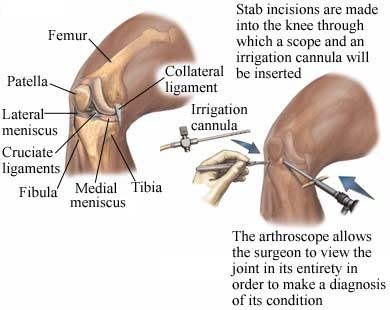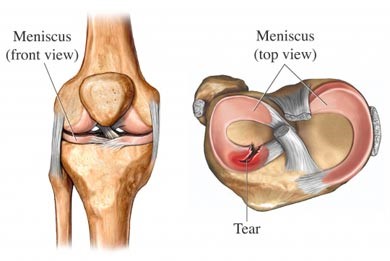What is knee arthroscopy?
Knee arthroscopy is a surgery done to visually examine a joint. Most of the time, it is done on large joints like the knee or shoulder to help diagnose an injury or condition. Arthroscopy is performed using a special tool called an arthroscope, which is an instrument that looks like a long tube with a miniature camera on the end. Using the arthroscope and other tools, surgeons make repairs or corrections to the affected joint.
A meniscal tear is a tear in the meniscus, or cartilage, which acts as a shock-absorbing structure in the knee. There are 2 menisci in each knee, a medial one on the inside, and a lateral one on the outside. There are different types of tears depending on the location and how they look. Treatment depends on the severity of the tear.
Diagnostic Arthroscopy of the Right Knee

Torn Meniscus

Who is most at risk for meniscal tears?
A risk factor is something that increases your chance of developing a certain disease or condition. Older adults and men are most at increased risk for meniscal tears. Other factors that may increase your risk include:
- Degenerative tears:
- Occupations that involve kneeling and squatting
- Climbing stairs
- Previous knee injuries
- Obesity
- Acute tears:
- Participating in contact sports, such as soccer or rugby
- Poor techniques for jumping, landing, pivoting, and cutting
What are the symptoms of a meniscal tear?
Symptoms may include:
- A popping sound at the time of the injury
- Pain and swelling in the knee
- Tightness in the knee
- Locking up, catching, or giving way of the knee
- Tenderness in the joint
When is knee arthroscopy most often used?
Arthroscopy is used to see, diagnose, and treat problems inside your knee joint. The procedure is most often performed to:
- Diagnose an injury or disease inside a joint.
- Remove bone or cartilage.
- Repair tendons or ligaments.
Most injuries to the meniscus are caused by trauma. This usually includes compression and twisting of the knee. Because the aging process tends to break down the inner tissues of the meniscus, minor trauma can injure the meniscus in an older adult. In cases of severe meniscal tears, surgical repair or removal of all or part of the damaged meniscus may be performed by arthroscopy.
Are there any potential complications from knee arthroscopy?
Problems from the procedure are rare, but all procedures have some risk. Your doctor will review potential problems, like:
- Infection
- Blood clots
- Swelling or bleeding
- Damage to blood vessels, nerves, or other tissue
- The need to have another surgery or more extensive surgery
Factors that may increase the risk of complications include:
- Pre-existing heart or lung condition
- Obesity
- Recent or chronic illness
- Diabetes
- Bleeding disorders
- Smoking
What to expect before, during, and after the knee arthroscopy
Prior to the Procedure
Before the arthroscopy procedure, your doctor will likely do the following to evaluate the joint:
- Physical exam
- X-rays
- MRI scan
In addition, prior to your surgery you should:
- Arrange for a ride to and from the procedure.
- Do not eat or drink anything after midnight the night before the procedure.
- Use a special soap, if provided to you beforehand, the morning of the procedure.
Anesthesia will prevent pain during surgery. The type of anesthesia you receive will depend on the joint your doctor is operating on. You may receive one of the following:
- General anesthesia —you are asleep.
- Local anesthesia—the area is numbed.
- Spinal anesthetic —your lower body is numbed by putting a numbing medication in your back.
During the Arthroscopy Procedure
Tiny incisions will be made in the skin along the joint. Special tools, including the arthroscope, will be inserted through the incisions. The picture from the arthroscope will show up on a screen so that the inside of your joint can be viewed. The images can be used to help the surgeon pinpoint where to cut and repair the tissue in your joint. For example, some meniscal tears in the knee are repaired by cutting and removing some of the cartilage.
When the surgery is complete, all tools are removed. The skin may be closed with stitches or clips, and the incision(s) will be covered with a dressing. Any fluid or tissue that was removed may be sent to a lab for examination.
The entire procedure usually takes less than one hour, but may be longer if repairs are done.
After the Procedure
The dressings can sometimes be removed as early as the next morning, but it takes 4-6 weeks for the joint to recover. Athletes often return to athletic competition within a few weeks. When you return home after the procedure, your doctor may suggest a physical therapy program. This will help speed your recovery and protect future joint function. Pain and discomfort after the procedure can be managed with medications.
The knee will need time to heal. Supportive care may include:
- Rest—Activities may need to be restricted at first. Normal activities will be gradually resumed as the injury heals.
- Ice—Ice therapy may help relieve swelling. You may be advised to use heat as you begin to return to normal activities.
- Compression—Compression bandages can provide gentle pressure to help move fluids out of the area.
- Elevation—Keeping the knee elevated can help fluids drain out or prevent fluids from building up.
- A knee brace to stabilize the knee.
- Crutches to keep extra weight off of the leg.
Contact your doctor right away if your recovery is not progressing as expected or you develop complications such as:
- Signs of infection, including fever and chills.
- Redness, swelling, increasing pain, excessive bleeding, or discharge from the incision site.
- Persistent nausea and/or vomiting.
- Pain that you cannot control with the medications you were given.
- Cough, shortness of breath, or chest pain.
- Joint pain, fatigue, stiffness, rash, or other new symptoms.
- Swelling, tingling, pain, or numbness in your toes that is not relieved by elevating your knee above heart level for 1 hour.
- Drainage.
If you think you have an emergency, call 911 for medical help right away.
Preventing Meniscal Tears
To reduce your chances of a meniscal tears, take these steps:
- Maintain proper technique when exercising or playing sports.
- Wear appropriate footwear for your sport and playing surface.
- Strengthen both the quadriceps and the hamstrings.
- Consider wearing a knee brace for sports.